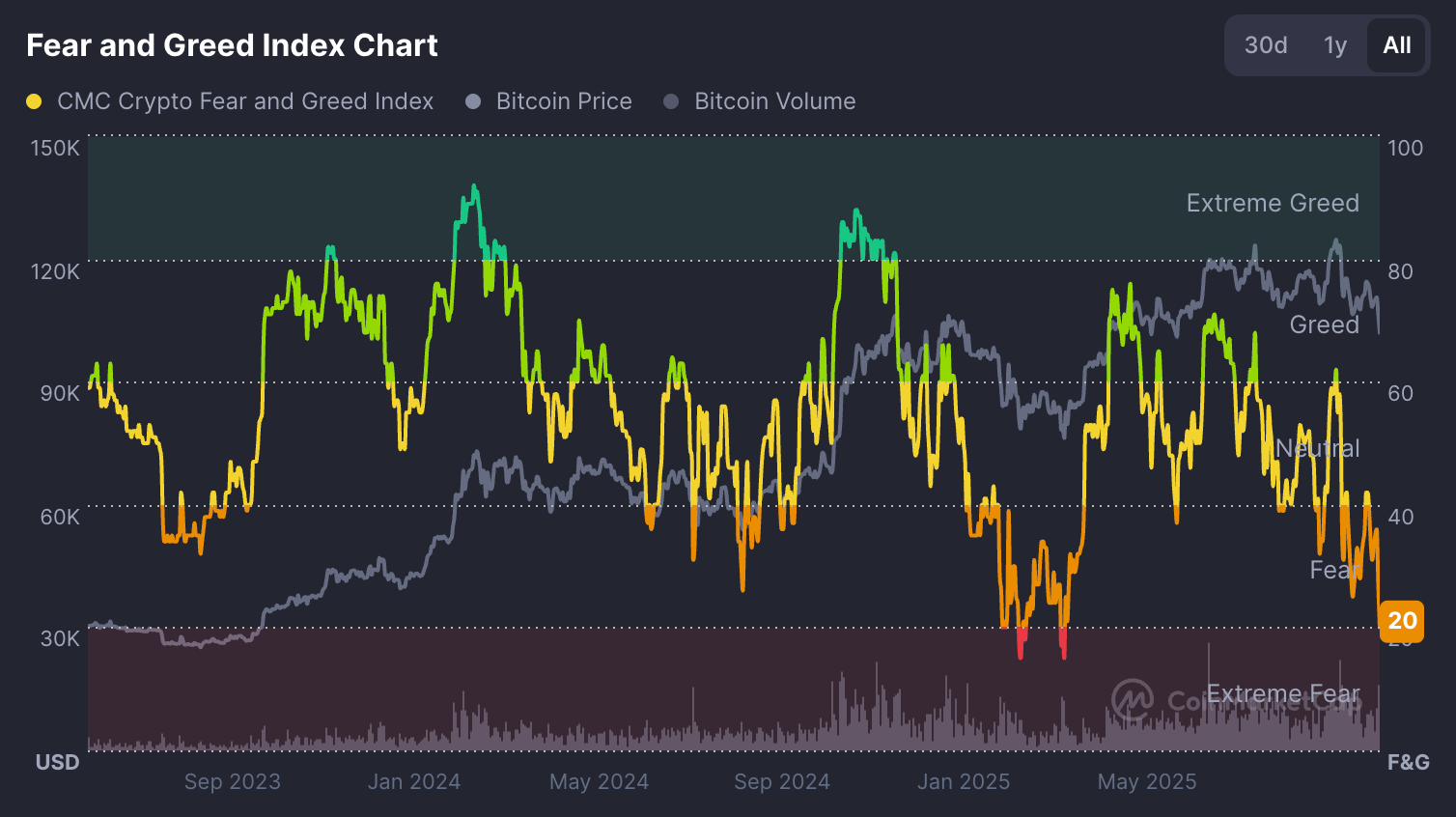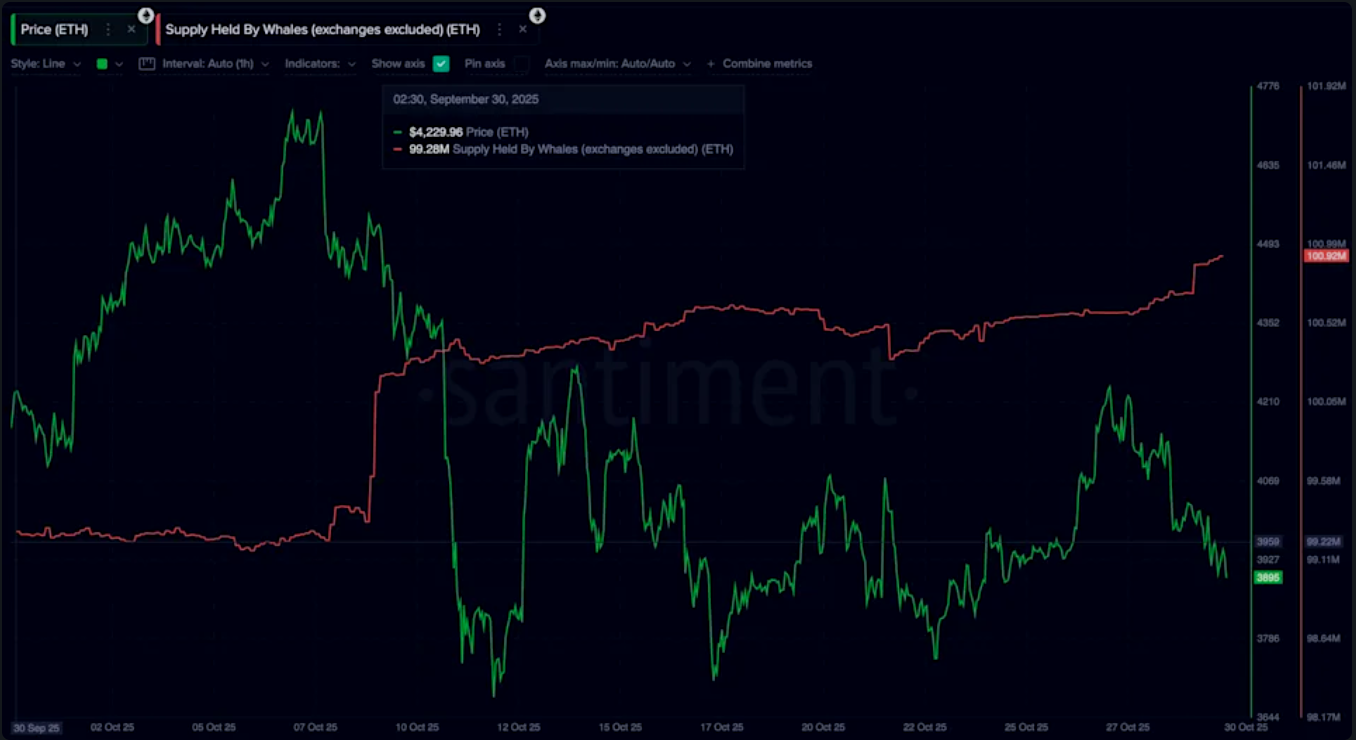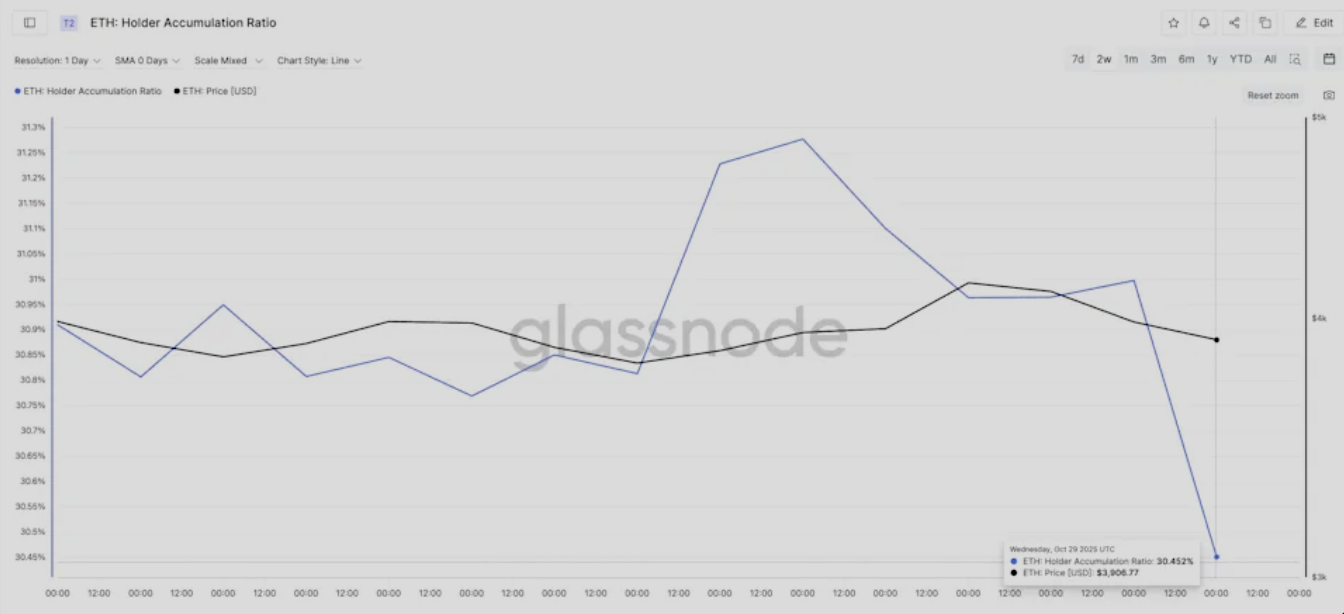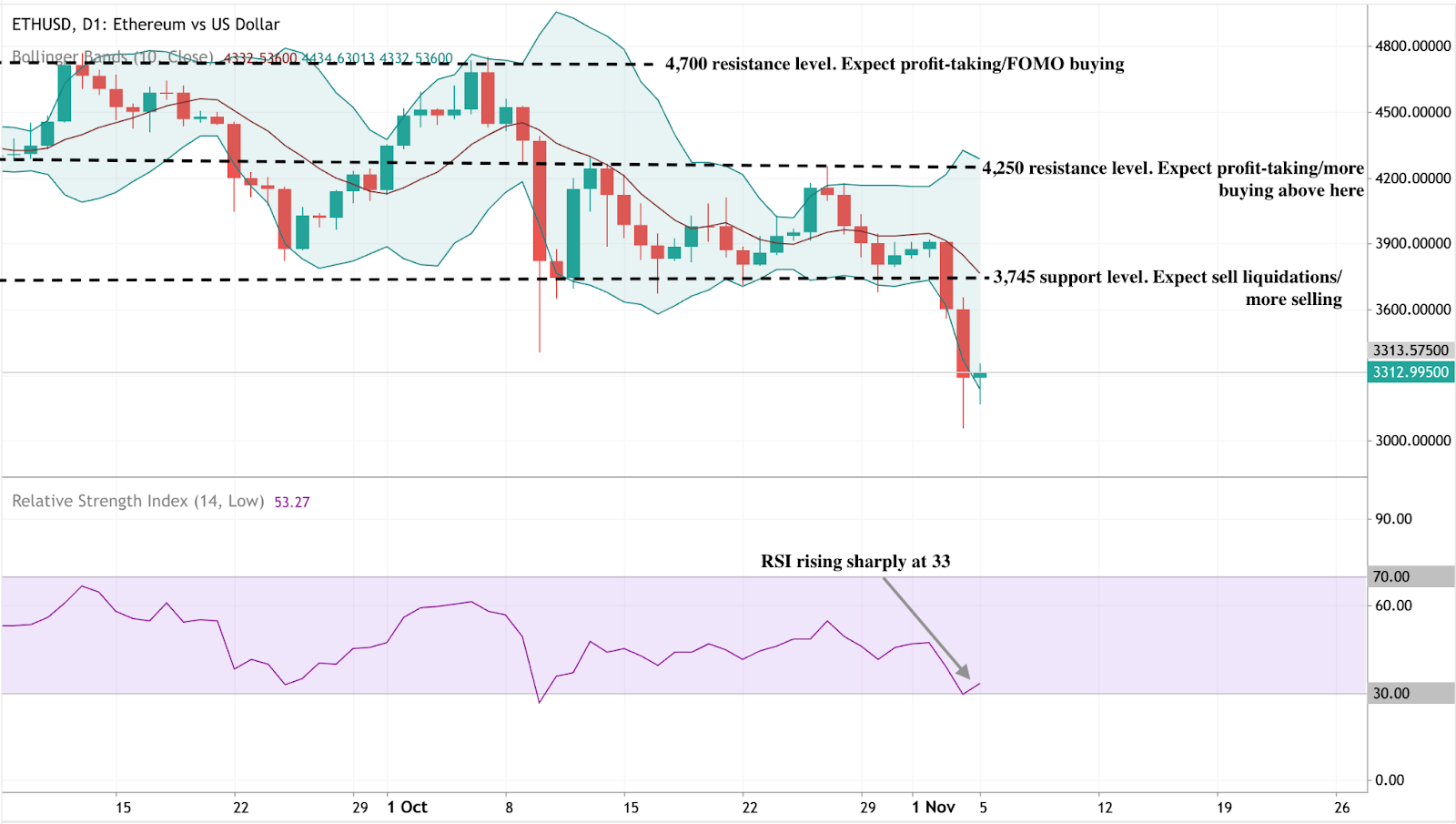Ethereum sell-off: Market reset or the start of a crypto winter?
Ethereum sell-off: Market reset or the start of a crypto winter?
Ethereum sell-off: Market reset or the start of a crypto winter?

Ethereum’s steep drop below $3,500 appears less like the onset of a new crypto winter and more like a healthy correction following months of strong gains. Data across on-chain, derivatives, and institutional channels point to a broad profit-taking phase, rather than a breakdown in fundamentals.
While retail investors and ETFs have become cautious, large holders and corporate treasuries are quietly accumulating, suggesting that this pullback may lay the groundwork for a potential recovery toward year-end.
Key takeaways
- Ethereum trades at around $3,312, down 8.92% over the past month.
- Roughly $1.1 billion in leveraged positions were liquidated in a single day, affecting over 303,000 traders.
- The Crypto Fear & Greed Index has dropped to 20 (“Fear”), down from 59 (“Greed”) the previous month.
- Whale wallets accumulated 1.64 million ETH (~$6.4 billion) in October despite the decline.
- The Fusaka hard fork (scheduled for 3 December 2025) will introduce PeerDAS, expected to cut Layer-2 fees by up to 95%.
- November remains Ethereum’s historically strongest month, averaging +6.9% returns over eight years.
Market sentiment turns fearful
Market confidence has eroded rapidly. The Crypto Fear and Greed Index has plunged to 20, signaling deep investor unease after weeks of optimism.

Across the broader market, every major digital asset has posted losses: Bitcoin (- 2.8%), Solana (- 11%), BNB (- 8.3%), XRP (- 6.7%), and Cardano (- 7.4%) in just 24 hours.
The overall crypto market capitalisation fell by $140 billion in a single day.
A stronger U.S. dollar and ongoing uncertainty at the Federal Reserve are intensifying the risk-off sentiment, reducing liquidity in speculative assets - a familiar trigger for crypto corrections.
ETH Whale accumulation intensifies while retail retreats
While headlines highlight fear, blockchain data tells a more nuanced story. Addresses holding 1,000–100,000 ETH grew their combined holdings from 99.28 million to 100.92 million ETH in October, according to Santiment.

This buying, amid falling prices, shows that institutional investors are viewing the correction as an opportunity rather than a warning. Meanwhile, smaller investors are stepping back.
Glassnode data show the Holder Accumulation Ratio slipped from 31.27% to 30.45%, signaling reduced activity among long-term retail holders.

This split - whales buying as retail pauses - has become the defining feature of the current cycle.
Institutional positioning: ETFs and treasuries diverge
Institutional behavior remains divided. U.S. spot Ethereum ETFs recorded $135.76 million in outflows on 3 November, led by:
- BlackRock’s ETHA: −$81.7 million
- Fidelity’s FETH: −$25.1 million
- Grayscale’s ETHE: −$15 million
Bitcoin ETFs saw similar redemptions of $186.5 million, as institutional desks trimmed exposure amid volatility.
Conversely, some corporate treasuries are buying aggressively. BitMine Immersion Technologies (BMNR) added 82,353 ETH (worth ~$294 million), bringing total holdings to 3.39 million ETH - about 2.8% of supply.
Chairman Tom Lee described the pullback as a “market reset,” noting that stablecoin transactions and application revenues are at record highs. He remains optimistic, forecasting ETH at $7,000 by year-end.
Liquidations reveal a market reset
The most dramatic evidence of the correction came from derivatives trading.
Data from Coinglass show over 303,000 traders liquidated in 24 hours, totaling $1.1 billion in forced closures. Nearly $300 million vanished within a single hour - mostly from over-leveraged long positions.
The clear-out, though painful, is structurally healthy. It has reduced speculative leverage, normalised funding rates, and left open interest - at around $19.9 billion - supported by more disciplined participants. Such leverage flushes often precede short-term stabilisation and renewed accumulation phases.
Fusaka upgrade offers long-term optimism
Even as traders grapple with volatility, developers are building for the next phase of growth.
The Fusaka hard fork, confirmed for 3 December 2025, will introduce Peer Data Availability Sampling (PeerDAS), boosting Ethereum’s capacity from 6 to 48 blobs per block. The result: faster throughput and up to 95% lower transaction fees on Layer-2 networks.
This technical leap could enhance Ethereum’s competitiveness in DeFi and scaling ecosystems, reinforcing its role as the backbone of decentralised applications. Stablecoin volumes - already reaching $2.8 trillion in October - demonstrate that Ethereum’s network remains fundamentally strong despite the market’s turbulence.
Ethereum’s November historical pattern: A bullish bias
Seasonality data offers a glimmer of hope. Over the past eight years, November has delivered average monthly gains of nearly 7% for Ethereum, with 2024’s 47% surge marking one of its best on record.
The Net Unrealised Profit/Loss (NUPL) ratio has dropped from 0.43 to 0.39, nearing levels that previously triggered significant rebounds. This decline suggests that selling pressure is waning as fewer investors remain in profit, a typical precondition for consolidation.
Macro context: profit-taking, not panic
Ethereum’s pullback aligns with broader market rotation away from risk assets. After a sustained rally, investors are locking in gains as global liquidity tightens and U.S. interest rate cuts appear less certain.
Crucially, this is not a repeat of the 2022–2023 downturn. Network activity remains high, DeFi revenue is stable, and whale accumulation continues. This pattern fits a profit-taking correction, not an exodus.
Traders using Deriv MT5 can analyse these cross-market correlations - between crypto, forex, and indices - to better understand shifting sentiment and manage exposure in real-time.
Ethereum technical insights: Stabilisation vs further weakness

Ethereum recently bounced from the $3,745 support zone after a steep sell-off, currently hovering near $3,313. This level has historically attracted buyers following liquidations, indicating early signs of accumulation.
The Bollinger Bands show widening volatility, while prices trade near the lower band - typically a sign of short-term oversold conditions. The RSI has rebounded from 33 toward 50, suggesting momentum recovery. A decisive close above the mid-band could confirm a short-term reversal, with resistance at $4,250 and $4,700 as potential upside targets.
Traders can use the Deriv trading calculator to evaluate margin requirements and potential profit scenarios before taking positions during such volatile swings - a crucial step in managing risk effectively.
Ethereum investment implications
For short-term traders, Ethereum’s setup offers tactical entry opportunities near the $3,500–$3,700 range, targeting $4,400–$4,600 if sentiment steadies.
For medium-term investors, current conditions look more like an accumulation phase supported by whale buying, the upcoming Fusaka upgrade, and seasonal tailwinds.
Institutional inflows may resume once macro visibility improves and ETF outflows subside.
In short, this correction resembles market normalisation, not meltdown. As leverage resets and fundamentals stay firm, Ethereum could be quietly preparing for its next move higher.
The performance figures quoted are not a guarantee of future performance.















